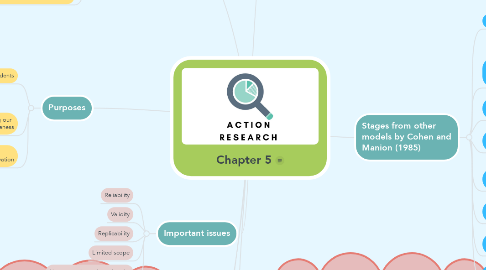
1. According to Martin Parrot (1996)
1.1. It is a state of mind
1.2. Scepticism about assumptions. Willingness to put everything to the test
1.3. It should take very little time
1.4. There's no need to make it public
1.5. It helps avoiding routine
2. IEXPRO University - Master's Degree on Teaching English Student: María del Carmen Laborde - References: Universidad IEXPRO. (n.d.). Observation and Research in the Classroom Context.
3. Characteristics
3.1. Elliott (1990)
3.1.1. Analyses human action and social situations: teachers & students
3.1.2. Exploratory approach
3.1.3. Aim: explaining what happens in the classroom; teaching contents.
3.1.4. Interpreting classroom events, values, beliefs
3.1.4.1. Beliefs, values, decisions
3.1.5. Direct simple language
3.2. Kemmis & McTaggart (1988)
3.2.1. 1 Carried out by classroom teachers (rather than outside researchers)
3.2.2. 2 Collaborative
3.2.3. 3 Aimed at changing things
4. Purposes
4.1. Learning about our students
4.1.1. Attitudes and preferences.
4.1.2. By posing questions
4.1.3. Teacher/learner diaries or journals
4.2. Reflecting and analysing our teaching and its effectiveness
4.2.1. Observation
4.2.2. By testing
4.3. Monitoring and evaluating innovation
4.3.1. Evaluateing before and after an innovation is introduce
5. Important issues
5.1. Reliability
5.2. Validity
5.3. Replicability
5.4. Limited scope
5.5. Not proposing universal truths
6. What is it?
6.1. Research on the smallest scale
6.2. By an individual teacher in the classroom
6.3. Investigating on teaching and learning
6.4. In specific contexts/ with specific groups of learners.
6.5. Taking an action, and systematically observing what follows.
7. 4 Classic Developmental phases
7.1. 1 Develop a plan of action
7.1.1. Improve what is happening
7.1.2. Identify and examine a problem area
7.2. 2 Act to implement the plan
7.3. 3 Observe the effects of action
7.4. 4 Reflect on these effects
8. Stages from other models by Cohen and Manion (1985)
8.1. 1 Problem
8.1.1. Evaluation
8.1.2. Identification
8.1.3. Formulation
8.2. 2 Preliminary discussion and negotiations
8.2.1. Interested parties: teachers, advisers, researchers, etc.
8.2.2. Draft proposal
8.3. 3 Review of research literature/ studies
8.4. 4 Restatement of the problem
8.4.1. Hypothesis
8.4.2. Discussion of the assumptions
8.5. 5 Seection: research procedures
8.5.1. Resources
8.5.2. Materials & Methods
8.6. 6 Evaluation procedures
8.6.1. Evaluation must be continuous
8.7. 7 Implementation of project
8.7.1. Data collection & Analysis
8.7.2. Monitoring & Feedback
8.8. 8 Interpretation of data
8.8.1. Overall project evaluation
